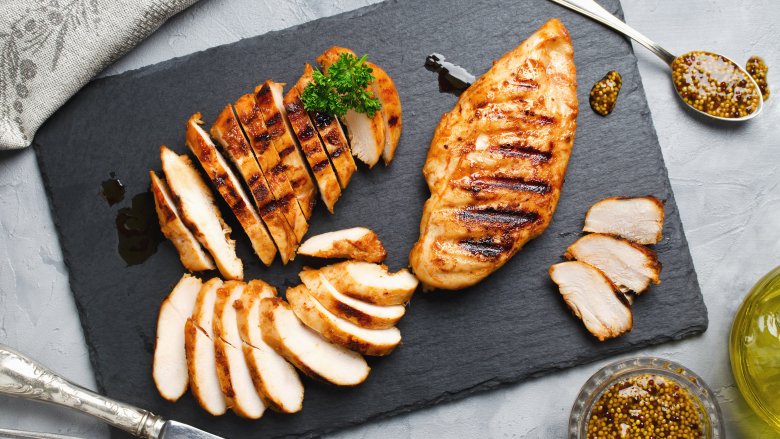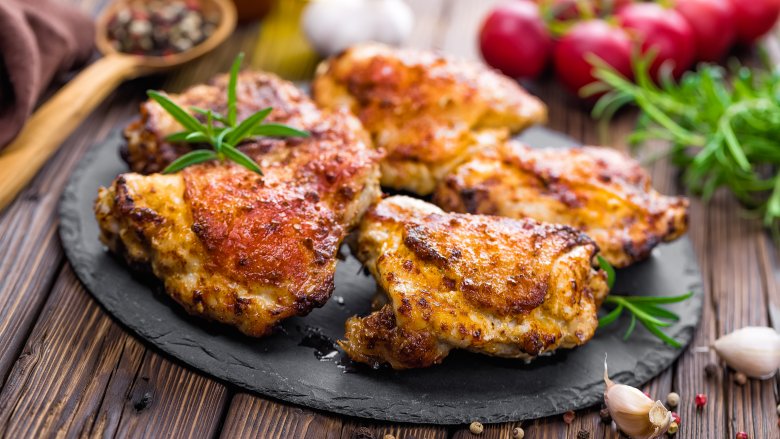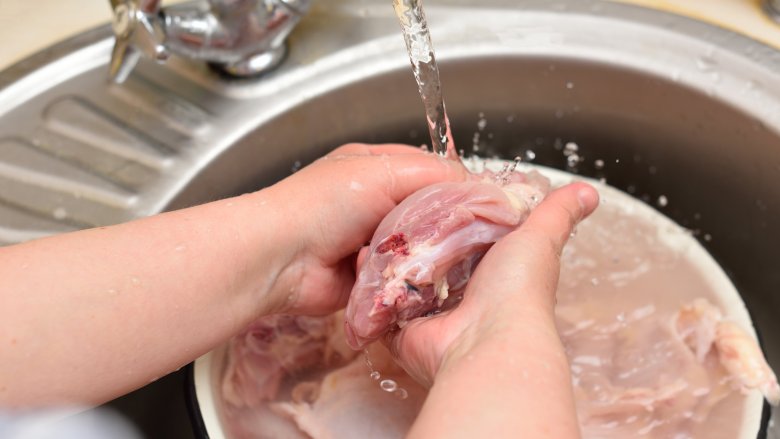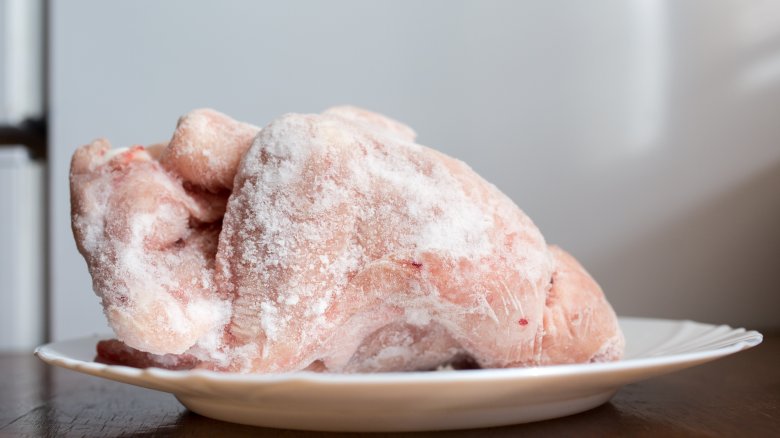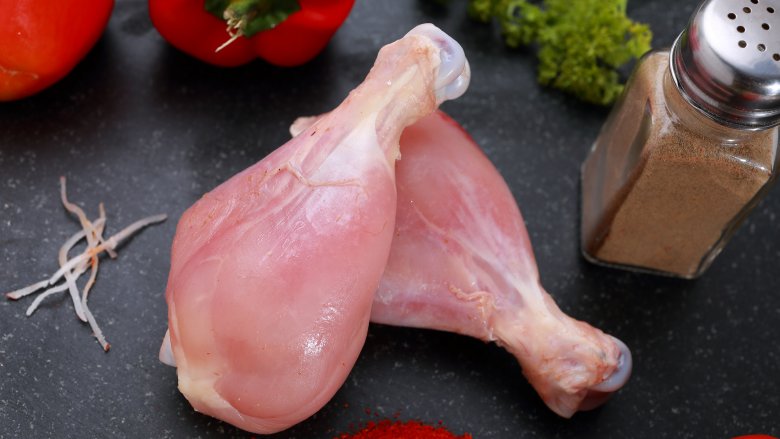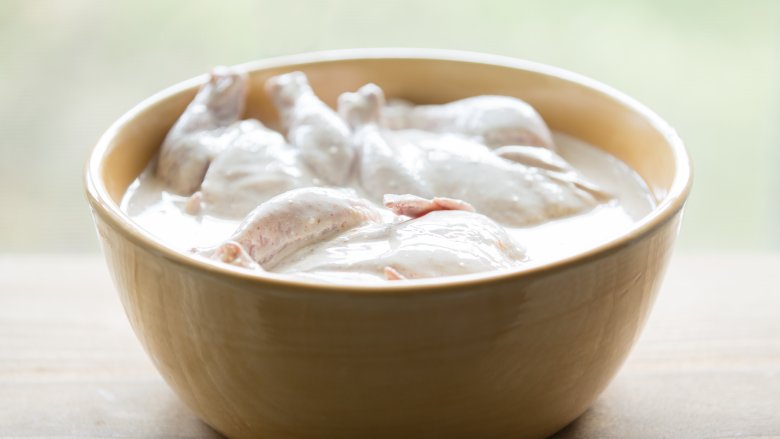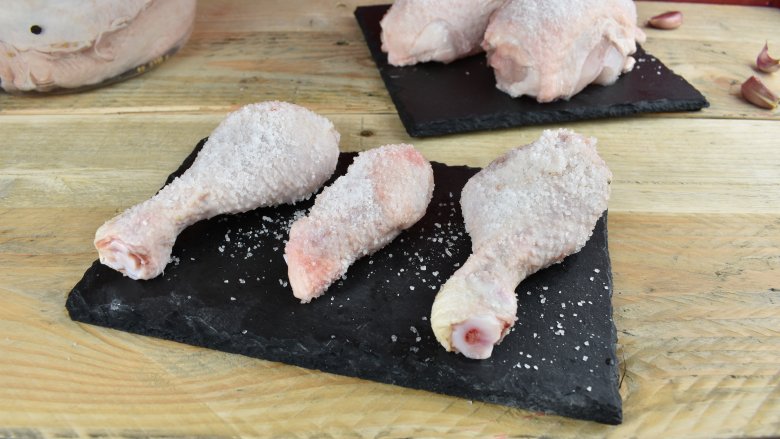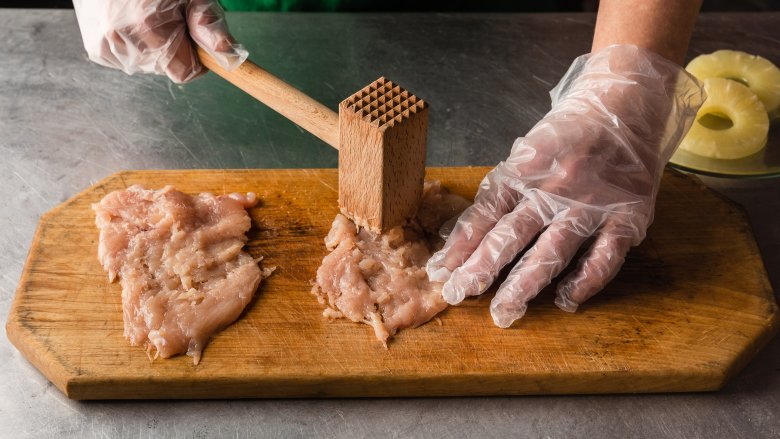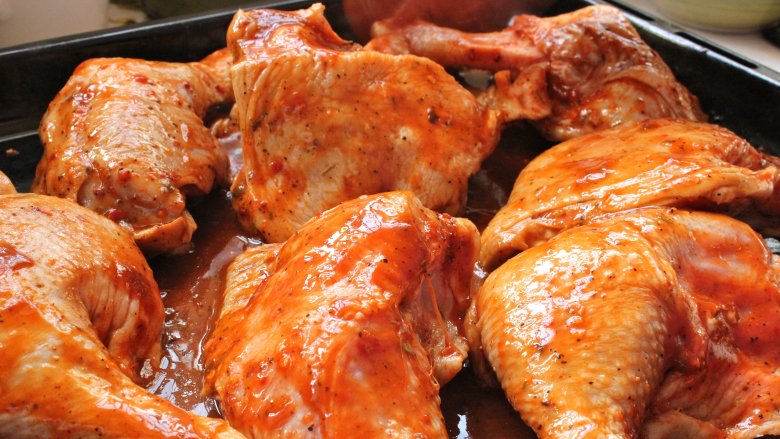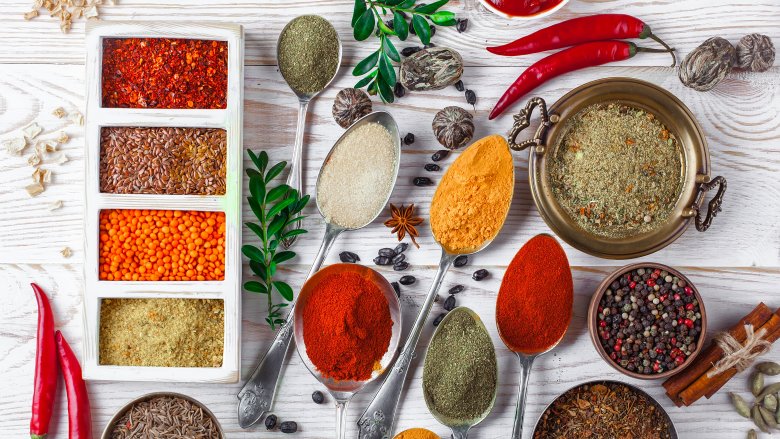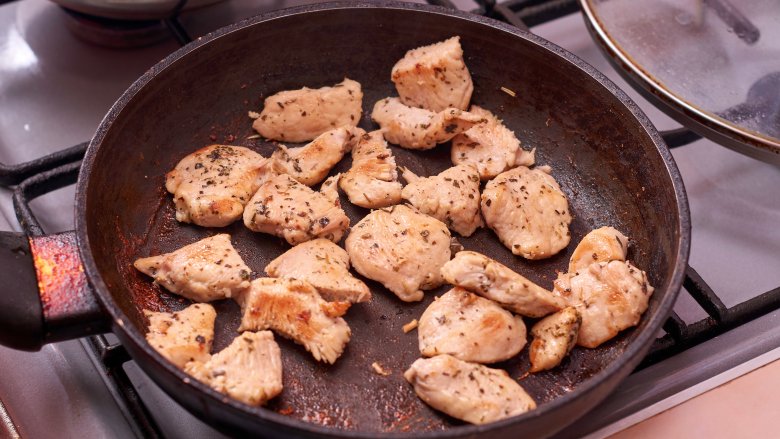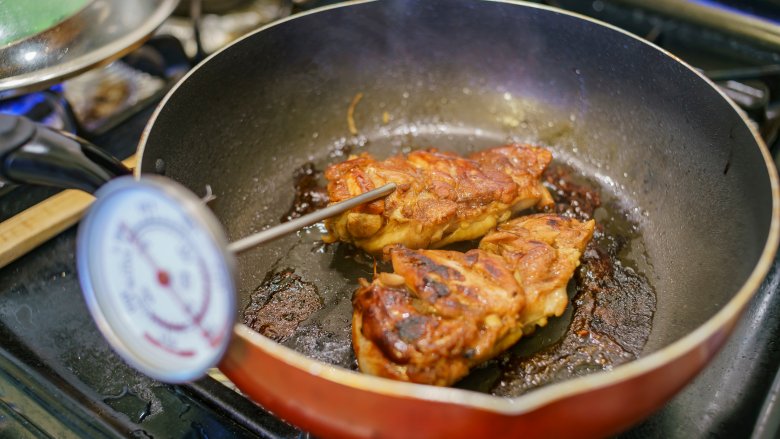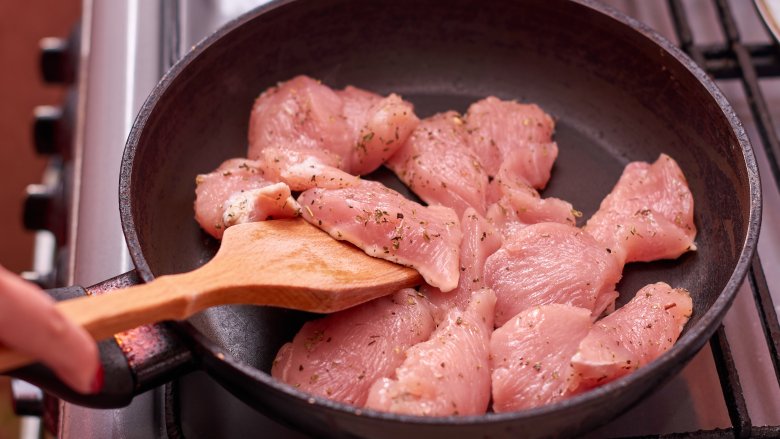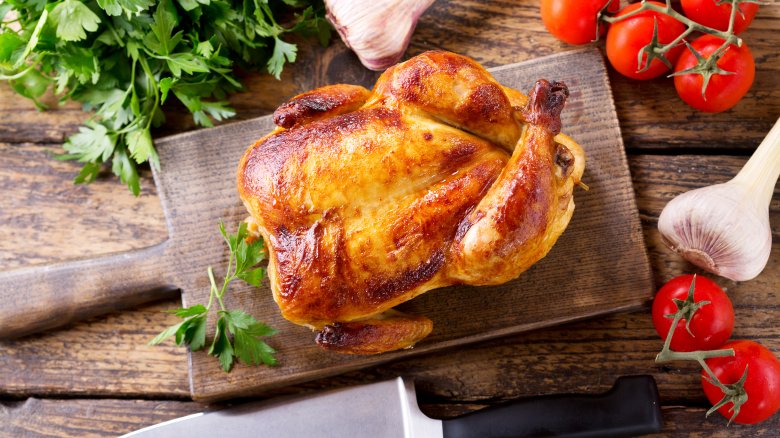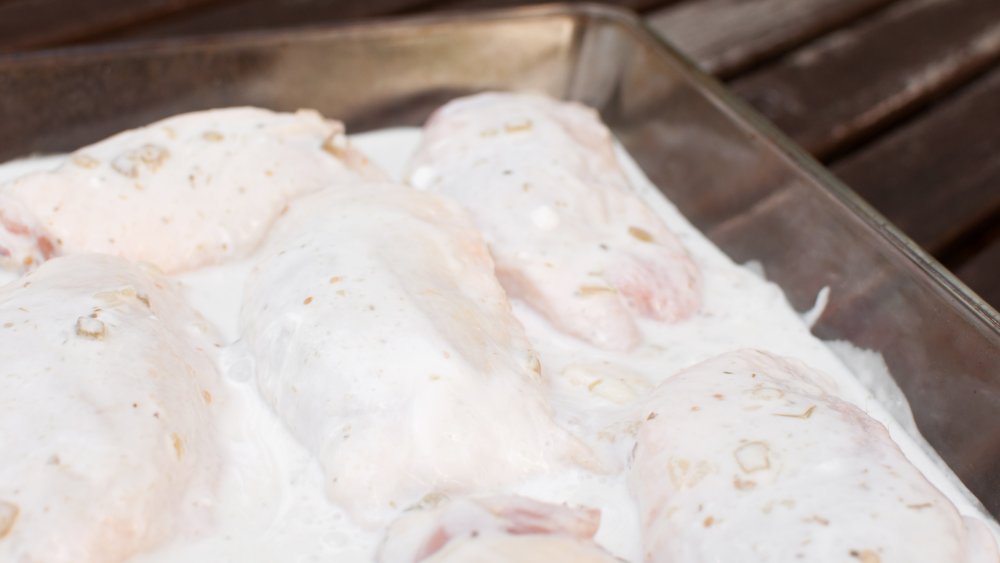Mistakes You're Making When Preparing Chicken
Chicken is great — on that we can all agree, right? Unless you've ascribed to a certain way of living (shout out to the vegetarians and the vegans), chicken can be a fantastic go-to meat for pretty much any occasion. Need a cheap Christmas alternative? Chicken. Got some pesto you need to get rid of? Chicken. Feeling the uncontrollable urge to deep fry something? Friend, you'd better believe that chicken's on the menu.
Unfortunately, chicken's status as a great all-rounder also means that it's often not taken quite as seriously by home cooks as, say, beef, pork or duck. All too many people tend to think of it as an "easy" choice of meat, but the truth is that getting it right — getting it really right, we mean — is actually pretty tough. You may even be surprised at just how many of these poultry-based mistakes you're still making in the kitchen. Sort it out, yeah? That chicken deserves better.
Choosing bad chicken
Just like with any kind of meat or fish, the first (and arguably most important) job when preparing chicken is choosing a high-quality cut or bird. People put a hell of a lot of thought into how their beef steaks look, smell, and feel before paying good money for them, and chicken really shouldn't be any different.
There are a few key ways you can tell whether your chicken is any good. Firstly, the meat ought to be bright pink all over (including in the crevice areas, such as the thighs and wings). If that chicken is going gray, it's going bad. The flesh should be firm but not stiff, and should be springy to the touch. Equally, chicken that has developed an odor should be avoided like the plague (because frankly, it might have the same effect on your body) and there should be absolutely no blood visible on the meat. Follow those rules and you'll be going home with a potentially tasty chicken.
Buying frozen chicken
Pre-frozen food is never your friend in the kitchen, and that goes just as much for chicken as it does anything else. See, the one thing you want in chicken is juiciness, and that juiciness comes from the meat containing a suitable amount of water. During the freezing process, however, meat dries out and loses much of its water content — meaning the eventual, cooked chicken is going to be almost totally devoid of those juices.
According to James Wilschke, executive chef at Hollywood's Filifera restaurant, you can't always trust a "fresh, never frozen" label, either. "I'm sure there are grocery stores that are overstocked on product," he told Food & Wine. "And if they don't want it to spoil, they might freeze it to just extend the life of it." If it's good meat you're after, your best bet will be heading to a butcher and sourcing your meat from there.
Only using the breast
There's nothing like a good, tender chicken breast to make a good meal, is there? After all, it's the cut of the bird with the most meat, as well as the one that's easiest to cook — plus it's super tasty. What's not to love?
Well, it might give you the most meat but the breast isn't actually the easiest to cook, and it's not the best, either. Too many people gravitate towards it because it appears to be the choicest cut, causing them to overlook some far more interesting parts of the bird. Arguably the most underrated of all: the chicken thigh.
The advantages of cooking with chicken thighs are numerous. They're far easier to cook (more-so than breasts, which are actually very easy to over-do), have a fantastic texture, season easily, and often just taste a whole lot better than the other parts of the chicken. Find a good recipe and you might never go back to breasts.
Washing it
By and large, the points we've hit so far on chicken prep have dealt with ensuring the meat you're using is high-quality and suitable, and results in deliciousness rather than disappointment. This, however, is an altogether more serious element of the cooking process. Put short: never wash raw chicken.
According to the NHS, running raw chicken under the tap will likely increase your risk of food poisoning from campylobacter bacteria. This is because the water droplets which splash onto the chicken from the tap can travel over a foot and half in any direction — onto cooking equipment, clothing, surfaces and, more likely than not, your own hands. And it really doesn't take much for you to be infected with campylobacter, a form of poisoning which causes stomach pain, severe diarrhea, and vomiting for up to five days. Worse (though rarer) complications can lead to arthritis, irritable bowel syndrome, and damage to your nervous system. Just trust the cooking process to kill bacteria — there's no need to rinse it.
Thawing on the counter
Ideally, you want to cook chicken fresh and avoiding freezing it at all. Sometimes, however, that's not an option — and so you're forced to stick it in the freezer and defrost it later. If that's the case, make sure you don't thaw it on the counter, or you're just asking for trouble.
According to the USDA, raw and cooked meat must be kept at a safe temperature during the thawing process. As soon as they begin to defrost (in fact, the moment they hit 40 degrees), bacteria that might have been present in the meat previously can multiply. This will also happen if you thaw chicken in hot water, or generally just allow it to sit out at room temperature for any longer than about two hours. If you've got to defrost chicken, the best way to do it is to let it slowly thaw in the refrigerator, where it'll stay at a cool enough temperature to stop all that nasty bacteria from spreading. You can also defrost it in cold water or in the microwave (as long as you get cooking from the very moment it's defrosted).
Removing the skin
One thing worth remembering — especially if you're cooking chicken thighs — is that there's never any good reason to remove the skin. In fact, some grocery stores even sell their own pretty-looking boneless skinless chicken thighs, hoping to appeal to people who think the skins are just a little too gross. Take it from us, though: these aren't worth your time.
Chicken skin has a number of uses during cooking. It acts as a kind of sponge full of tasty juices, and if you leave it on, they'll be released to the meat during the cooking process. It also protects that same meat from the heat, and allows the thigh to cook at a slower pace and retain its moisture. If you take the skin off before cooking, there's a good chance that what you find on the other end is a dry, tasteless chicken thigh that might as well be an overdone breast. If you really, really don't like the skin (but why?) then remove it after cooking instead.
Not brining it
Okay, first reaction — gross, right? Nothing attractive has ever come out of brine. Don't swear it off just yet, though, because brining your chicken before you cook it can be a crucial part of the whole process. It adds flavor, keeps the meat juicy, and even reduces the risk of overcooking.
There are a few ways to do this. The wet brine is basically a solution of salt, sugar, water, herbs, spices and aromatics, which you then bring to a boil and stir to allow those flavors to really stew together. After that, you let the whole thing become cold (don't want those bacteria joining the party) and then submerge the pre-cooked bird or cuts, leaving them to brine for up to two days in the refrigerator. Dry brining is a similar technique in which the salt, sugar and seasonings are rubbed straight onto the meat, allowing for a quicker turnaround since they'll soak in after just a few hours. Whichever method you choose, the chicken that ends up on your plate is guaranteed to be far tastier and more exciting than anything you've made before.
Not drying your meat
The word "dry" might seem like anathema to anyone wanting to cook up a good chicken, but the truth is that drying out your meat after brining is a must-do for any poultry cook worth their salt. According to James Wilshcke, doing this will help encourage the caramelized outer crust which makes all good chicken even better "People want to get really crispy meat, and the general rule of cooking is moisture is the enemy of caramelization," he told Food & Wine. "When you want to get meat crispy, you want the skin as dry as possible."
You should air dry the meat out of its packaging in the fridge for up to four hours (though much longer can occasionally be more suitable, and Wilschke himself lets it dry for a day or two if he's making fried chicken), before taking it out and patting it down with a clean paper towel.
Not tenderizing it
This is a must-do on the preparation checklist if you've got chicken breast in mind for your recipe. Many of the issues that come with cooking chicken breast can actually be mitigated, if not avoided altogether, with a good bit of heavy tenderizing prior to cooking.
Pounding the chicken helps spread out the thickness and allows the meat to cook more evenly and quickly. The process also makes the resulting chicken juicer and tastier, which is especially helpful considering chicken breast can often be neither of those things. The method is simple. All you have to do is wrap up the chicken in plastic wrap (a plastic storage bag will do), grab a heavy object such as a ladle or sauce pan, and start hitting it. Start from the thick part of the cut and slowly work your way to the thinner bits, until the whole thing is finally thin and flat. Once that's done, you're ready to season and cook. Easy!
Messing up the marinade
Marinating chicken, like brining, can be an excellent source of flavor for your meat. But it is possible to get it wrong — and doing so can leave your chicken in any number of bad states. If it's exposed to the marinade for too long, it can go from being tender to mushy and stringy. If it doesn't spend enough time marinating, it'll fail to soak up all those spices, making the whole ordeal a massive waste of time.
The golden rule is this: never marinate chicken for more than 24 hours. And you don't need to come close to that deadline, either — marinating chicken for only 15 to 20 minutes can still completely transform it. In the end, leaving your meat in marinade for two days does nothing except ruin the chicken and waste your precious time. If you've really got that time to spare, stick to brining. It'll come out far better.
Under-seasoning
This is probably the most downright criminal mistake people can make while cooking chicken, but we'd hazard a guess that it's probably a fairly common one, too. Please, people, for the sake of your friends and family — for yourselves — don't forget to season your chicken. Meat that only has salt and/or pepper added to it is bad enough, but serving up something without even that ought to be deserving of a jail sentence.
Here are some golden rules for seasoning chicken. Salt is the big dog, but you've got to get it right. Try to use kosher salt or sea salt to keep sodium levels down and your accuracy levels up. Make sure the other seasonings you're using are suitable for chicken: good starting points include basil, rosemary, garlic, mustard, paprika, thyme, parsley, celery seed, cumin and cayenne; but don't be afraid to play around. You never know what will work, and a failed experiment is always — always — going to be far more satisfying than a tasteless, unseasoned husk of a bird.
Cooking straight from the refrigerator
This might go against the instincts of anyone who's particularly safety-conscious when it comes to handling and preparing raw meat, but it's actually a good idea to let your chicken sit out for a little while before you cook it. Tempering chicken essentially allows it to come to room temperature, which has a few key benefits: it'll help your chicken hit that key temperature (more on that in a minute) more quickly, helps the chicken cook more evenly all the way through since the center isn't colder than the edges, and the end result will be juicer, too. And that's never a bad thing, is it?
As long as you're careful, this process isn't going to cause you any harm, either. Don't allow it to sit out anywhere it can come into contact with other food, wash your hands, and don't let it sit out for too long (no longer than two hours) and you'll be just fine.
Under-cooking
No surprise here, but it's always worth saying just in case: always make sure your chicken is cooked to a hot enough temperature, otherwise you're just asking for a world of pain to come crashing down on top of you. The U.S. Department of Agriculture states that the ideal temperature for chicken to be cooked at is 165 degrees.This temperature will effectively destroy salmonella bacteria, which is the most heat resistance of the pathogens that regularly grow on raw poultry. Certain cuts require higher temperatures, albeit for quality reasons more than safety ones. For example, whole muscle breast meat should be cooked at 170 degrees, while whole muscle thigh meat should be cooked as high as 180 degrees.
The best way to ascertain whether your chicken has cooked through enough is to get a food thermometer. Stick it into the meat, make sure it's hit that golden number and keep cooking if it hasn't. It's a good habit to take on.
Overcrowding the pan
This is another common mistake made during the actual process of cooking. If you're pan-frying, pan-searing or sauteing chicken, you ought to make sure the pan is never overcrowded. This is because one of the main things which gives chicken its flavor is browning, a reaction which happens when the food comes into contact with very high temperatures. Unfortunately, if the pan is too crowded the moisture that comes off the chicken will have no room to spread and evaporate and end up turning into steam or water instead. Instead of browning, the chicken will end up steaming. In the end, you'll end up with poached chicken.
This is all easily avoidable — just make sure there's plenty of room for the chicken in the pan, and the pieces aren't overlapping or smashed up against each other — but getting it wrong can completely ruin your dish. And when you've spent so much time tenderizing, brining and seasoning the meat, that's going to feel just a little heartbreaking.
Not letting it rest
This is the last thing you should do before serving up your chicken, especially if it's a roast. Resting involves allowing the chicken to sit out for anywhere between 10 and 20 minutes once it's cooked. The reasons for doing this are twofold: firstly, cutting into chicken straight away can cause liquid to pool out and cause the actual meat to end up dry. Allowing it to sit for a while will help the chicken absorb the moisture back into the meat. Secondly, meat tends to continue to cook even after you've taken it out of the oven, and it's always good to let it continue to do so — in fact, many recipes suggest taking meat out of the oven just before it's done cooking for this reason.
Take the chicken out, keep it in foil to make sure it stays warm, and keep yourself otherwise occupied for a while. It'll all be worth it in the end.
Not soaking it in milk
Wait, just a minute! Hear this one out before you nope on out of here!
When you're cooking chicken, you want it tender, right? One way to do that is to soak it — not in a more typical kind of marinade, but in milk. It really does work, and we found out why: lactic acid.
While other marinade ingredients you might think of first — like lemon juice and vinegar — work their magic to tenderize the meat because of acid, milk works in a similar way due to the lactic acid present in it. Lactic acid breaks down meat proteins and makes it that much more tender, and that's a win. Some suggest there's a double whammy going on here, and the calcium in milk also has tenderizing benefits... although that's less scientifically proven.
And if you're making fried chicken, you should definitely use a milk soak — specifically, buttermilk. According to Robby Melvin from Time Inc. Food Studios (via My Recipes), those acids in the buttermilk help break down the chicken's skin, which help add the exact amount of crispiness you want, at the same time it helps keep the breading sticking to the chicken. The New York Times suggests that it's exactly this principle that's at work whether you're frying or roasting your chicken, and they also say buttermilk helps give your aromatics an extra kick. It's a win no matter how you look at it!
